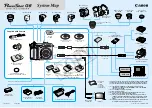
V1.02
Thom Hogan’s Complete Guide to the Nikon D300
Page 683
dueling profiles, as sometimes happens when you’ve got
Adobe Gamma loading at startup.)
If you
can
follow color from camera to print and get good-
but-not-perfect results, you probably see very minor color
shifts that you want to correct. My advice: isolate whether the
shift occurs camera-to-computer or computer-to-printer. If
you see both, work on the camera-to-computer side first.
You should be able to shoot a known color source, such as
the GretagMacbeth ColorChecker chart using a custom white
balance and see the correct colors on your monitor. I haven’t
seen differences in color rendering between different D300
bodies, so I generally don’t find that profiling the camera is
useful, as even small white balance issues will more grossly
affect color than individual camera variation. Thus, camera-
to-computer color shifts are almost always the result of
incorrect settings on your computer software (e.g. Color Space
doesn’t match what the camera set).
Once your camera-to-computer color issues are resolved and
you get repeatable, accurate results on the display, then and
only then work on the print side. First, examine all the options
for your printer driver and make sure that one of those doesn’t
“fix” your problem.
More often than not, selecting the right paper and ink choices
are all that it takes to get close (especially on Epson inkjets
using Epson papers). If you use custom papers or inks, you
may have to profile your printer, which is out of the realm of
this book (but do go to
http://www.inkjetmall.com
and look at
their paper/ink/profiles; these are as accurate as you can make
on your own).
Another thing to look for is that only one program or driver is
doing the color correction for printing. If you print from
Photoshop, for instance, it’s possible to set your system up so
that both Photoshop and your Epson print driver are both
trying to handle color correction. Check the various Epson














































